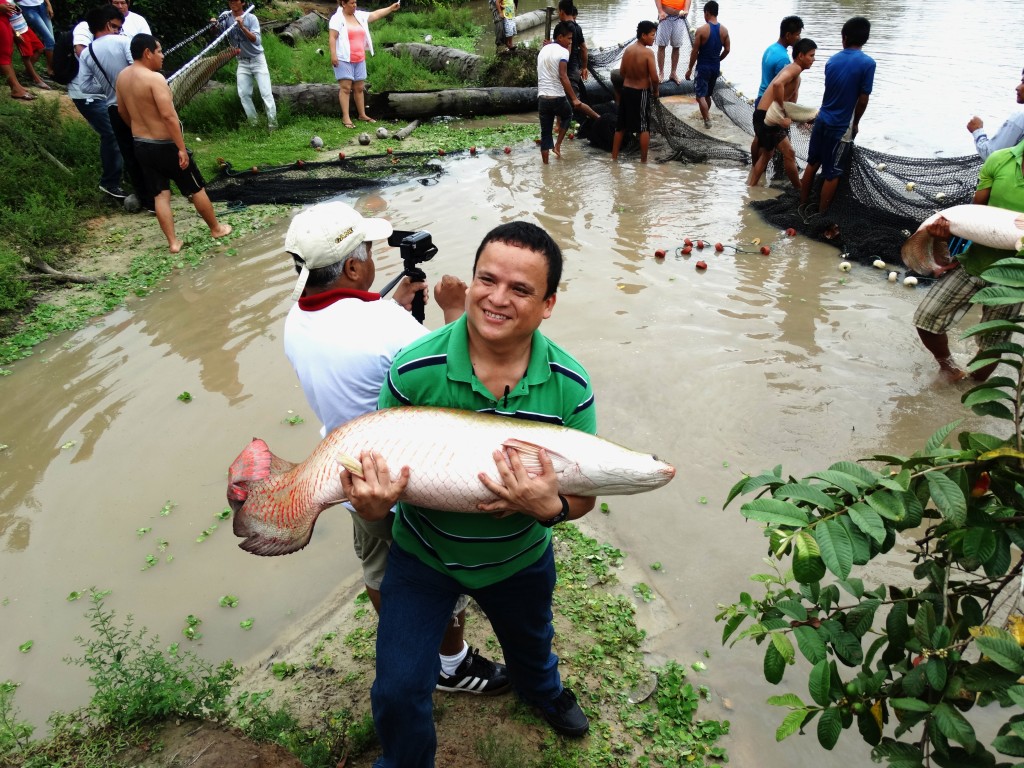The gap between what farmers and forest dwellers receive for their products and what these are ultimately sold for in rich country markets is often staggering. Adding more value to sustainable natural products and selling them more directly are often seen as options for closing this gap to help producers keep a bigger share of the final product’s value. And while there are some great examples of capturing value this way, the much reviled ‘middlemen’ often play crucial roles – more partners than parasites.
The Amazon, with over 2200 fish species, sustains local villages and urban markets with tens of thousands of tons of fish a year. It’s incredibly productive, pure potential — and frequently overfished to near collapse. In Pacaya Samiria National Park in Peru, local management groups can get exclusive stewardship rights to designated lakes, allowing them to avoid the tragedy of the commons and sustain yields of emblematic species like the 100-kg paiche (Arapaima gigas), which have been garnering growing interest in high-end restaurants in Lima, Latin America’s new foodie mecca. But the communities are far upriver and remote, and if any product is sensitive to just-in-time delivery, it’s fresh fish. So fish are usually sold dried-and-salted in local markets, a practical solution to storage and travel without adequate refrigeration, but a tragedy and shame with the rarely-tasted delicacies of these murky waters.
Enter the ‘responsible middleman:’ Miguel Tang, with an enthusiasm, both limitless and contagious, for all things fishy. Tang is a social entrepreneur, co-founder of an NGO called AMPA, and has worked for years in Amazon fisheries biology, both as a farmer of fish and prawns himself, and as an advisor to indigenous and riverine communities of the vast, swampy, lagoon-studded jungles of northeastern Peru. Tang ties together both ends of the supply chain, working closely with restaurateurs in Lima who want fresh, sustainable Amazon fish on their menu and the communities who produce it. By coordinating the orders, promoting lesser-known species and advising fishermen on how best to clean and store the fillets, Tang acts as a key link in the chain, enabling the communities to get nearly three times more for their fish than they would traditionally.
Talking to restaurateurs like Pedro Miguel Schiaffino of Lima’s top-rated ámaZ and Michelangelo Cestari and Kamilla Seidler of Bolivia’s Gustu, they’ve emphasized to us the importance for them of having a direct relationship with the producers of the fresh, quality products that make their dishes outstanding. But they also highlight how they’d love to find more intermediaries for these natural products that can help make these business relationships work better – ensuring quality, stability and timeliness of delivery and even such basic things as formal invoices.
The role of partnerships in the value chain is explored in fascinating academic detail in research piece by Carla Morsello and colleagues in the online journal PLOS ONE looking at how both partnerships with companies and local processing affected community well-being and conservation for remote indigenous communities of Brazil and Bolivia, producing non-timber forest products like Brazil nut and andiroba oil. The study and its nuanced conclusions are worth reading in full. They found that many measures of community well-being improved in the cases where communities established partnerships with corporations using their products as ingredients (e.g., The Body Shop). But one of the most striking — and counterintuitive – findings was that local processing, where communities assumed greater responsibility for providing more refined or finished products to “add value” actually had the contrary effect, reducing net income and other measures of wellbeing. Though the underlying reasons aren’t altogether clear, the researchers point to the fact that while partnerships provide benefits in the form of guaranteed sales and premium prices, the value added by local processing may be more than offset by increased costs for local producers engaged in these new activities. Of course, we need to be careful in extrapolating: communities, markets, partnerships and products vary dramatically, but it’s worth bearing in mind that local processing and value added is not the silver bullet it sometimes seems.
Responsible brokers, processers, exporters, importers and all the other links in the supply chain for sustainable natural products from tropical farm to supermarket shelf exist and survive in part because they are specialized, add value and absorb risk. Value chain approaches can help identify opportunities for inclusive partnerships and greater benefits to producers. And making these value chains work is a key idea behind fair trade certification – the chocolate bar on a Belgian supermarket shelf may not be producer-owned and integrated from farm to store, but the certification aims to ensure that the links of the supply chain are working in a way that transparently allows an equitable portion of the price to flow back to producers.
The challenge for producers is understanding their markets, frankly assessing their capacities, and finding the partners they need.



fantastico!!!!
really great article, great summary and very on point for today’s market driven conservation efforts that you seem to be promoting. good luck! keep up the great work!